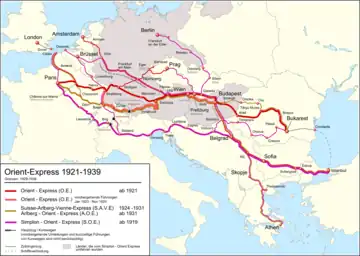Orient Express
international long-distance passenger train service
The Orient Express was a legendary train service between eastern and western Europe founded in 1883. While the route changed over the years, the traditional final destinations were Paris and Istanbul.
While the traditional main route through the Balkans closed down in 1962, and the last through sleeper car on any route from Paris to Istanbul departed in 1977, a few portions of the regular service in Western and Central Europe continued on a limited and diminishing scale until the Orient Express name disappeared from mainline European rail timetables forever in December 2009. The introduction of high speed rail in much of Western and Central Europe, as well as the rise and falling price of aviation, have led to the demise of many sleeper train services. The original incarnation of this route is among them.
Understand

The original Orient Express service was inaugurated by la Compagnie Internationale de Wagons-Lits (CIWL) in June 1883 from Paris to Vienna and was extended Paris to Istanbul in October 1883. Departures originated from Gare de l'Est in Paris. This route contained steamship or ferry crossings until at least 1889; these were eliminated once the journey could be completed entirely by rail. From 1889 to 1962, the main route was largely unchanged: from Paris through Strasbourg, Munich, Vienna, Budapest and Bucharest to Istanbul (Constantinople) in Turkey. It connected many of the great empires of its time: Britain, France, Germany, Austria-Hungary, and the Ottoman Empire.
This route survived through much of the Cold War, an era in which it passed behind the Iron Curtain then back into Western-controlled territory. One isolated terrorist attack against the train was perpetrated 13 September 1931 by a lone madman, detonating explosives on a viaduct in Biatorbágy (near Budapest) as the train was travelling to Vienna. This knocked an engine and nine cars off the track into a ravine thirty metres below, killing twenty and injuring hundreds. Service on all of the multiple Orient Express routes (the original route, the 'Simplon' and the 'Arlberg') was interrupted during the Great War (suspended 1914, resumed 1919) and Second World War (suspended 1939, resumed 1945).
|
It's murder on that Orient Express
In late Jan 1929 the Simplon Orient Express from Paris was nearing the end of its journey to Istanbul. But the snow got deeper and deeper: finally the train juddered to a halt outside Çerkezköy, 50 miles short of the city. And there it remained stuck for the next five days, completely buried in snow, with passengers and crew in an increasingly desperate plight. That particular train did not convey (as far as we know) any murderous fugitives, diamond thieves, star-crossed lovers, spies, batty aristocrats with saturnine manservants, or any other character that might gainfully employ an actor in Edwardian costume topped by a fez. Nor did it, on that occasion, carry Agatha Christie – but she didn’t miss it by much, and would soon redress its other deficits. Born Agatha Miller in 1890, she’d married army officer Archie Christie in 1914. By 1926 the relationship was broken, he left for a weekend with his new lover, and she staged a dramatic disappearance: leaving her car poised above the cliffs at Beachy Head while she lay low at the Swan Hotel, Harrogate, until spotted there ten days later. The couple divorced in 1928 and Agatha set out on the Orient Express for an extended tour of the Middle East – before meeting Archie she’d spent several months in Egypt. It was on this tour that she met Max Mallowan, in Iraq where he was working as an archaeologist. They married in 1930 and in later years she often rattled round the Levant and Middle East by train and other transport. So the stuck train, bracketed by her own travel experiences, had a personal link apart from its literary potential. Sitting in the Pera Palace Hotel Istanbul in 1934, she cast a cold eye over her fellow voyagers, and began to write her next novel. |
The primary historic routes (all interrupted during both world wars) were:
- Orient Express (1883–1962) from Paris through Strasbourg, Munich, Vienna, Budapest and Bucharest to Istanbul. A fragment of this route from Paris to Budapest was revived in 1977, but was cut back to Paris–Vienna (2001) and later Strasburg–Vienna (2007) before disappearing completely in 2009. Initially this route was chosen over the shorter southern route taken by the Simplon Orient Express below because of an Austro-Hungarian legislation of that time, which required all international trains crossing the Austrian territory (which included a short section of the southern route around Trieste, then) to make a stop at the capital city, Vienna, rendering the southern route infeasible until the collapse of the empire.
- The Simplon Orient Express (1919–1962) aka Direct Orient Express (1962–1977) from Paris through Lausanne, Milan, Venice, Belgrade and Sofia to Istanbul was an alternate service which ran in parallel to the main Orient Express for many years, crossing into Italy at the Simplon Pass tunnel. A fragment of this journey was revived (1982–2005) as the Venice Simplon Orient Express from Calais and Paris through Lausanne and Milan to Venice, but that train did not continue onward to Istanbul.
- An Arlberg Orient Express (1930–1962) ran as a third route from London via Calais through Paris, Zürich, Innsbruck, Vienna and Budapest, before either terminating in Bucharest or going through Belgrade to terminate in Athens. These runs never did go to Istanbul; their access to the United Kingdom was, by necessity, a ferry crossing in this era.
This effectively ends the original Paris–Istanbul route in 1962 (leaving just the Simplon route) and completely ends all service to Istanbul by 1977.
With the 1977 withdrawal of la Compagnie Internationale de Wagons-Lits (CIWL) from the Orient Express, ownership of rolling stock passed to individual national rail systems (which operated fragments of the route in Western Europe 1977–2009) or to private collectors. Much of this equipment still exists; a partial train was assembled as the museum exhibition Il était une fois l'Orient Express in 2014 at the Arab World Institute in Paris, and some original wagon lit cars are used for the privately-owned heritage tourist train in the modern era.
The Orient Express is famous as a result of multiple appearances in film and literature. The best known are Agatha Christie's "Murder on the Orient Express" and Ian Fleming's "From Russia with Love" — one of the James Bond series from the Cold War era. The train occupies a central role in novels "Stamboul Train" and "Travels with My Aunt" by Graham Greene.
Prepare
.jpg.webp)
The routes of the Orient Express span multiple countries and, if retraced using modern rail services, multiple trains. While most of this route is in the Schengen zone, any border crossing past the southern and eastern borders of Croatia and Hungary will encounter additional passport or visa requirements, although the visa policies of the countries in the eastern portion of the route are mostly aligned with that of the Schengen area. England, as part of the Ireland-UK travel area, has its separate visas and immigration policies.
See the individual country articles for specific visa and immigration restrictions. If you start from London, mind the quite lengthy security/immigration/customs check.
You will want to plan your journey in time. The dedicated services have sparse schedules (the one to Istanbul partly with original stock just once a year) and tickets to many of the normal trains are expensive if bought late. You may also have to do some planning around services not connecting well. You might want to seize the chance to explore cities on the way.
Get in
While this journey may be made from either endpoint (Paris or Istanbul), it is most commonly done from west to east, departing the Gare de l'Est in Paris, France. As Paris is the main hub of France's extensive rail network as well as the seat of one of Europe's most important airports (Charles de Gaulle Airport CDG), getting to Paris should be no major challenge.
Go

By heritage service

Today, there is a touristic service, departing once a year, by Belmond: Paris–Budapest–Sinaia–Bucharest–Istanbul. This "Venice Simplon Orient Express" is a tourist train, which is both expensive (over US$9000/person, one way) and slow (six days from Paris to Istanbul, with a lengthy overnight hotel stay and tour of Budapest). It provides luxury and uses some of the original rolling stock, which travelled the rails in the heyday of the Orient Express in the 1920s and 1930s.
There are other runs, operated by the same company, which go from London through Paris to Venice or other cities, such as Berlin. This operation is seasonal. While these use Orient Express rolling stock and branding, they do not directly correspond to any of the historic itineraries associated with this train.
By multiple modern trains
Starting from the West, the beginning of the journey is rather straightforward. The route is in the heart of many countries' high speed rail services, and indeed the Paris–Budapest route has been prioritized as the "Magistrale for Europe" by the EU. There are also sleeper services. While the original service wasn't modern high speed, it wasn't deliberately slow, so either may fit your perceptions of the "modern equivalent".
There is direct service from London to Paris via Eurostar. From Paris there are several departures daily to Strasbourg and connecting service to Munich via TGV (and ICE on German soil). There is also one daily direct ICE/TGV from Paris to Munich. From Munich both DB and ÖBB (Austrian railways) offer connections to Vienna, which is only 60 kilometres (1 hour by train) away from Bratislava, the capital of Slovakia. As you go east from here train speed gets significantly lower, but sleepers are still a common sight, so you might change your travel from the daytime to nighttime.
In the east, the modern Bosphorus Express service to Istanbul runs from Bucharest or Sofia. This train lacks the luxury of the original Orient Express and the one key advantage of the original: an ability to seamlessly move the same privately-owned wagon-lit sleeper cars from one national system's trains or engines to those of another, so that passengers can make the end-to-end Paris-Istanbul journey without disembarking from the carriages.
It takes three or four nights (on as many different trains) to get to Istanbul from Paris on the modern system. Each leg (or a system pass, such as the Interrail pass) must be purchased separately; there is no single ticket from Paris (or London) to Istanbul. All rail systems from Britain to Austria (i.e. those two and Germany as well as France) have various offers for reduced advance purchase fares (often limited to just the booked train with limited or no refunds if you miss said train), and therefore buying a ticket "last minute" can be a rather expensive proposition, especially for long distances. However, if you are flexible with dates and willing to travel at 1pm Tuesday, you can get advance cross-country fares for as little as €19 (less if you apply for certain discounts). The countries of the former Eastern bloc tend to have comparatively low flat rates with little difference for type of train or time of purchase as of early 2020s, but advance purchase offers (and more expensive base fares) are becoming more and more common even there.
Via Bucharest
Take the TGV Paris–Strasbourg–Munich; continue eastward to Budapest. There is a train from Budapest to Bucharest. From Bucharest, you can board the Bosphorus Express to Istanbul.
This is the closest match to the original route. However, it takes four days, as connection times do not align well between some of these trains in the east.
Via Belgrade
Take the TGV Paris–Strasbourg–Munich. Go from Munich to Zagreb, then to Belgrade. From Belgrade and Sofia you can board the Balkan Express, a branch of the main Bosphorus Express to Istanbul.
Connection times do not align well between some of these trains in the east.
Optima Express
Something of a combination of the rather expensive heritage train and the connections requiring multiple modern trains is the Optima Express, a car train operating between Villach (Austria) and Edirne on the European side of Turkey. The train takes 33 hours for the trip and tickets can be booked with or without taking your own horseless carriage on the train. Departures are up to twice a week in the summer season (roughly Apr–Nov). Single tickets for adults not taking a car with them start from €149 in a berth in a six-berth compartment. Of course, to do the full Paris–Istanbul trip, you have to arrange train tickets for the rest of the trip also, which should be easy on the Paris–Villach leg but might be surprisingly challenging on the Edirne–Istanbul leg.
Go next


The original journey ends in the Sirkeci Terminal, built for the Orient Express in 1890 as the main European station in Istanbul. A famous example of European Orientalism, its architect deliberately decided to use this style to invoke a feeling of "the east" for the incoming passengers. As of 2022, only Marmaray commuter trains serve the station (and then at a considerable depth underground), but its central location is easy to reach by local trams and commuter rail, and there is a tiny one-room museum in the station with artifacts from the Orient Express era.
A room at the Pera Palace Hotel (built in 1892 as the first European-style hotel of the city specifically for the passengers disembarking from the Orient Express so they would not miss the western luxuries common back at home) in Pera across the Golden Horn from the station, where Agatha Christie penned Murder on the Orient Express, is preserved in her honour.
Turkey has a fledgling and expanding high speed rail system but due to major redesign of the Istanbul area rail network all trains to Asian destinations in Turkey depart from Söğütlüçeşme, a suburb some distance away from the traditional centre on the Asian side, which nevertheless is quite an easy ride away from elsewhere in the city thanks to the cross-city commuter services. Söğütlüçeşme station, on a modern viaduct, of course pales compared to the glory of Sirkeci or Haydarpaşa (the traditional and planned to be future Asian terminal station) but it does the job for the time being. YHT services go to Ankara, Eskişehir and Konya among others but further extensions of the network are planned.
Before 2003, it was possible to transfer to another premier passenger train once operated by the Compagnie Internationale de Wagons-Lits, the Taurus Express (Turkish: Toros Ekspresi), mentioned briefly in the opening chapter of Murder on the Orient Express. This train continued from Istanbul's Asian terminal through Syria to Baghdad (and had connection services all over the Middle East as far away as Cairo back in its heyday, hence connecting all three continents of the Old World), but was discontinued due to the US invasion of Iraq. The Turkish-domestic portion of the route was partly revived with standard Turkish carriages in 2012, running between Konya and Adana across several early 20th century tunnels and viaducts through the mountain range it is named after. While the northern section of the former route can be roughly traced by Turkish high speed rail, as of 2023 restoration of service in the south is unlikely due to ongoing conflicts in both Iraq and Syria; see the overland itinerary from Istanbul to Cairo for a version of the route.
It is nominally possible to continue from Istanbul to New Delhi over land, either as a stand-alone journey or part of a longer trip round the world overland in the style of Jules Verne's Around the World in Eighty Days. This trip, however, is not without complications due to the unfavourable political situation in much of the Middle East and central Asia.
See also
- Heritage railways
- Tourist trains
- Rail travel
- Rail travel in Europe
- Sleeper trains
- Tips for rail travel
- Trans-Siberian Railway, a similarly famous long sleeper journey that is still possible without changing trains